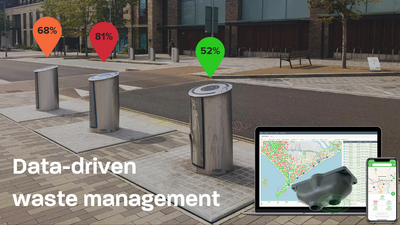Smart Waste Management : "Digitisation and waste optimisation are the inevitable future"

Can you explain how sensor technology is used in waste management and what specific types of sensors are commonly employed?
Sensoneo Waste Monitoring technology allows cities and businesses to understand the complex dynamics of their waste production. The solution provides real-time online access to data related to monitored bins, boxes, or containers. The Waste Monitoring solution combines Smart Sensors, the Smart Waste Management Software System, and the Citizen App. Sensoneo Smart sensors measure fill levels in bins via ultrasonic beams. Our sensors can monitor any type of waste (mixed waste, paper, plastics, glass, clothing, bio-waste, liquids, electronics, metal….) in bins and containers of various types and sizes. Sensoneo’s solution is a result of in-house R&D.
How do sensors help in monitoring waste bin fill levels, and what impact does this real-time data have on optimizing waste collection routes and schedules?
Smart Sensors are designed to monitor fill levels in trash bins and containers using ultrasonic technology. Sensors transfer data simply via all currently available IoT networks and/or GPRS. Sensors monitor all types of waste in bins and containers of different sizes. Based on this data, customers can collect only full bins and containers or adjust bin capacity and distribution to avoid overflowing bins and contamination. Using our technology, they are provided with data-driven decision-making, and optimization of waste collection routes, frequencies, and vehicle loads resulting in a significant reduction of costs.
Could you provide examples of other environmental parameters that sensors can measure, apart from fill levels, and how this data is used to enhance waste management efficiency?
Sensoneo sensors are robust, water and shock-resistant. They have a fire alarm, so apart from fill levels, they measure temperature to overcome fires.
Related article: "Deep learning enables the sorting of new materials"

How do sensors and data analytics contribute to optimizing waste collection and disposal processes?
Using our sensors, customers are provided with data necessary for informed decision-making. They get an overview necessary to adjust bin capacity and distribution and can collect only full bins and containers. Our solution enables them to understand the dynamics of waste production and eliminate overflowing bins and contamination.
How do sensor-equipped waste bins and collection vehicles interact with central control systems, and how is this communication managed?
The Smart Sensors use ultrasound technology to measure the fill levels in bins several times a day. Using mobile wireless networks, the sensors send the data to Sensoneo’s Smart Waste Management Software System, a cloud-based platform, for data-driven daily operations, available also as a waste management app.
Like our content? Subscribe to our newsletters!
Today, every waste producer and processor is aware of the enormous value of data and is implementing solutions to collect it.
Are there specific sensor technologies that are better suited for indoor or outdoor waste bins, and how do environmental conditions influence their accuracy?
Ultrasound technology is, at the time, the most suitable for any environmental conditions, no matter indoors or outdoors. Ultrasound is extremely effective and resistant to a dirty and dark environment inside waste bins.
Are there any cost considerations associated with implementing sensor technology in waste management, and how does the return on investment typically manifest?
When it comes to ROI by implementing the sensor technology it typically manifests the most by long-distanced containers and remote bins. The same applies to underground bins where collection of waste takes a longer time, so it is good to have the information about the fill level. While some customers might achieve ROI in 7 months, we acknowledge that every city and every customer’s situation is unique.
Could you share an example of a real-world implementation of a smart waste management system and the positive impact it had on efficiency or sustainability?
A good example is the smart monitoring in underground bins in Prague. In the Czech capital, Sensoneo has already installed almost 2,000 sensors to measure waste in waste bins and this number continues to grow. The main goal of representatives of the City of Prague was to create an effective tool for monitoring the fill level and condition of underground bins with separated waste. This tool provides the city with information they are using for the optimization of waste collection routes, the creation of predictive models for the planning of collection routes, and the placement of new waste containers. The entire project is in line with the Smart Prague 2030 plan; which also includes „the zero waste plan“, which is based on responsible, intelligent waste management.
Related article: "Smart waste management promotes recycling and reduces operational costs"
Can you discuss any challenges or barriers that municipalities or organizations might face when adopting and implementing smart waste management technologies?
There is still not sufficient infrastructure of IoT networks to implement the solution to all bins everywhere. You cannot implement the solution in the bin where there is no network, it won’t send you any data, so it is necessary to expand the network.
Another challenge is to change the mindset of waste collectors towards dynamic waste collection and apply novelties.
Are there any specific regulations or standards that govern the use of sensors in waste management, particularly when it comes to data privacy and environmental monitoring?
Our data is purely about waste, so it is not personalized and is not subject to data privacy. In some countries there might be restrictions when it comes to data leaving the country, so we must use a local database instead of the cloud. However, in the majority of countries we are allowed to use cloud-based databases.
What role do cloud-based platforms and data storage play in managing the large amounts of data generated by sensor-equipped waste management systems?
The same as in every industry, cloud-based platforms make it much easier to implement and scale our solution fast.
Read more on the topic here: "Data-driven sorting and compositional analysis is becoming vital"
Digitisation and waste optimisation are the inevitable future. Our advice would be to start as soon as possible. The smart waste management approach is a future that cannot be avoided, not only to improve services to citizens but also to save the environment and make data-driven decisions. It is important to start sensibly and implement smart waste solutions step by step exactly where they make sense to achieve the best results.
What advice would you give to municipalities or waste management companies that are considering transitioning to a smart waste management approach?
Digitisation and waste optimisation are the inevitable future. Our advice would be to start as soon as possible. The smart waste management approach is a future that cannot be avoided, not only to improve services to citizens but also to save the environment and make data-driven decisions. It is important to start sensibly and implement smart waste solutions step by step exactly where they make sense to achieve the best results. There are types of sites and containers where sensors are essential to improve services to citizens, avoid contamination, and save the environment.
What trends do you see emerging in the field of smart waste management, and how do you anticipate these technologies evolving in the coming years?
Data is essential for making efficient and informed decisions that directly save financial costs and the environment. Today, every waste producer and processor is aware of the enormous value of data and is implementing solutions to collect it. In a circular economy, waste is seen as a resource, not just a burden, and every producer and processor needs to know how much, where, and what waste is being produced in real time. Municipalities, together with waste collectors, are moving towards digitalization and optimization based on data from sensors. In the future, we will see more accurate sensors with longer-lasting battery life. Sensors will be capable of measuring more environmental parameters, for example, the level of methane in the bin. Sensors will be capable of recognizing the exact contents of the waste in bins. All this information will allow the automation of the waste management industry and dynamic waste collection in the future.
Related article: Digital solutions help make waste management more efficient


